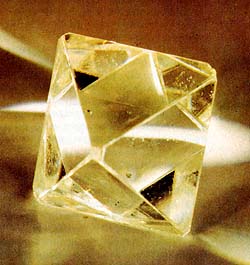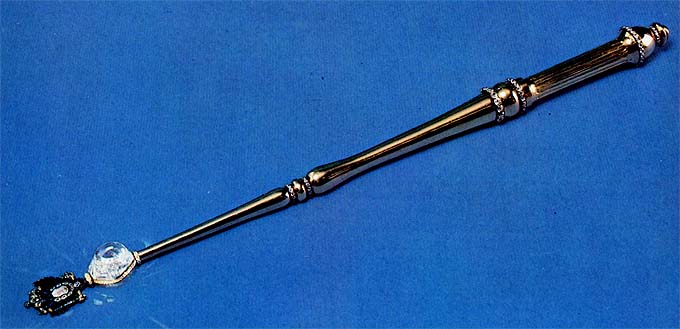Diamond is the hardest and one of the most expensive minerals in the world
Diamond
Chemical formula: C (crystalline carbon).
Cleavage: perfect.
Singonia: cubic (crystals of octahedral, transitional and rhombododecahedral habit).
Color: most Yakut diamonds are colorless, faintly smoky, rarely greenish-yellow, inky-violet, very rarely light aquamarine (bluish-greenish and bluish), bottle green, lilac- and brown-cherry. Ural diamonds are mostly colorless.
Hardness: 10 (the hardest).
Density: 3.47 (stones of "pure water") - 3.56 g / cm ".
Breaking: smooth, stepped, shell.
Transparency: transparent.
Light refraction: n = 2.417 (colorless), n = 2.46 (with increasing impurities).
Dispersion: 0.044.
Glitter: strong diamond (a combination of high light refraction and exceptional hardness).
Pleohroizm: absent.
Absorption (clear lines): 478 nm (colorless); 504 nm (brown-yellow).
Luminescence: different, colorless - blue, brown - green.



Diamond "Miner" 44.6 carats. Diamond "50 years of the CPSU". 71.5 carats. Diamond "Star of Yakutia". 232 carat. Yakutia. Diamond fund. Moscow.
The name of the mineral comes from the Greek. "Adamant" is irresistible. The hardness of a diamond exceeds by a thousand times the hardness of quartz and 140 times - corundum. Due to perfect cleavage along the octahedron (in four directions), under the impact of sharp impacts, the diamond can easily split along planes parallel to the faces of the regular octahedron. This property of diamond was used in antiquity, giving it a certain shape before processing. Currently, it is processed with a diamond tool, powder and paste. Requires special attention when cutting and inserting diamonds into metal frames.
The diamond is resistant to chemical reagents, in X-rays the diamond is completely transparent unlike diamond-like and synthetic minerals.
Optical properties of diamonds are shown sharply. The "play of light" of a diamond crystal is explained by the high refractive index and dispersion. A ray of white light, refracted in a crystal, gives a widely divergent bundle of rays and, therefore, shines more brightly with all the colors of the rainbow. By transparency, diamonds are divided into several categories.
Impeccable diamonds are those in which even under a 10x magnifying glass one can not detect defects. However, even the purest crystals have different inclusions and impurities, on which the absorption of rays in one or another part of the spectrum depends, and this affects the color effects of the diamond.
The special properties of diamond attracted attention to it even in ancient times. It was used as an ornament and was a symbol of power and wealth. At present, the diamond is still the king of gems, the standard of beauty and value. It is used in the jewelry industry, and also as a unique technical stone.
The value of a diamond depends not only on its transparency and color, but also on the faceting - the quality of polishing and the shape of a diamond, made of diamond, and the value of the quantity and increases in proportion to the square of its mass in carats. The most valuable are the colorless diamonds of "pure water". The usual forms of diamond cutting: "marquise", "diamond", "pear-shaped". The most attractive - "diamond", giving the crystal maximum brilliance and "diamond game."
The main deposits of diamonds in the CIS in Russia are related to the kimberlite formation of the Siberian diamondiferous province, discovered in 1954, where except for small diamonds, dozens of unique diamonds were found, which were given their own names. A diamond weighing 32.5 carats was found in the Mir kimberlite pipe in 1956, in the Udachnaya tube - in 1957 - a cluster of transparent octahedral crystals of 54.1 carats. Later, diamonds of different mass were found. The largest of these is the diamond "XXVI Congress of the CPSU", found in the tube "Mir" in 1979; Its mass is 340 carats, the shape is irregular rounded.
In the Diamond Fund of Russia one of the largest cut diamonds of high quality is stored - the diamond "Orlov". Placer deposits are known in Siberia, on the area of the diamondiferous province, and in the Urals, where the first diamonds were found in 1889.

Diamond "Orlov" in the scepter. 1770 year 189.62 car. Diamonds, silver, enamel.
Included in the number of seven historical stones stored in the Diamond Fund of Russia, Moscow
Popular gems, which are represented on the territory of the CIS (former USSR)
- Diamond is the hardest and one of the most expensive minerals in the world
- Alexandrite (chrysoberyl) - one of the rarest and original stones
- Beryl (group of beryl) - heliodores, emeralds, aquamarines, morganites
- Turquoise - blue and green precious stone of the East
- Granat (group of pomegranates) - popular inexpensive gems
- Jadeite is a popular stone used in the Neolithic
- Pearls - traditional and favorite decoration of the Slavs
- Quartz (a group of quartz) is an extremely popular mineral in collections
- Corundum (group of corundums) - colorless corundums, rubies and sapphires
- Lazurite - blue stone of the high blue mountains of Pamir and Afghanistan
- Malachite - the Ural malachite is considered the best in the world
- Jade is the sacred green stone of Chinese emperors
- Feldspars - Labrador, Moonstone, Sun Stone, Amazonite
- Rodonit (orlez) - a beautiful pink stone of the Urals, a stone of Russia
- Topaz - blue, yellow, wine and polychrome minerals
- Tourmaline - original gems of all colors and shades
- Fluorite is a valuable mineral used in industry
- Chrysolite - magmatic mineral, transparent garnet olivine
- Spinel was relatively recently identified as an independent class
- Amber (fossil resin of ancient trees) - frozen time
- Jasper - an unusual mineral with a wide palette of coloring


Comments
Commenting on, remember that the content and tone of your message can hurt the feelings of real people, show respect and tolerance to your interlocutors even if you do not share their opinion, your behavior in the conditions of freedom of expression and anonymity provided by the Internet, changes Not only virtual, but also the real world. All comments are hidden from the index, spam is controlled.